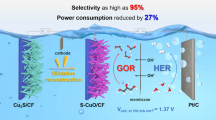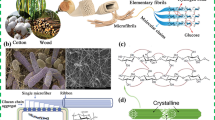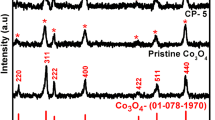Abstract
The decentralized production of H2O2via a two-electron oxygen reduction reaction (2e− ORR) has emerged as a promising alternative to the energy-intensive anthraquinone (AQ) process. However, its practical application requires 2e− ORR electrocatalysts with high activity and selectivity. Herein, we report the synthesis of metallic Ni nanoparticles anchored on bacterial cellulose-derived carbon fibers (Ni-NPs/BCCF) via a facile impregnation-pyrolysis method as efficient electrocatalysts for 2e− ORR to H2O2. By tuning the amount of Ni precursor, the best electrocatalytic performance toward 2e− ORR was achieved for Ni-NPs/BCCF-20.7, affording a high H2O2 selectivity of ∼90% and an onset potential of 0.75 V vs. reversible hydrogen electrode (RHE) in an alkaline electrolyte. Ni-NPs/BCCF-20.7 achieved the largest H2O2 yield rate of 162.7 ± 13.7 mmol gcat−1 h−1 and the highest Faradaic efficiency of 93.9% ± 4.2% at 0.2 and 0.5 V vs. RHE from the bulk ORR system, respectively. Theoretical calculations revealed the more favorable “end-on” adsorption configuration of molecular oxygen on the exposed Ni(111) plane, which can effectively suppress the O-O bond dissociation, resulting in high selectivity for H2O2 generation.
摘要
通过两电子氧化还原反应(2e− ORR)原位分散生产过氧化氢 (H2O2)是一种很有前途的、能替代传统的能源密集型蒽醌法的过氧化 氢生产方法. 然而, 其实际应用高度依赖于高活性、高选择性的两电子氧 还原电催化剂的设计与合成, 并且仍面临挑战. 本文利用生物质材料细菌 纤维素调控合成金属镍纳米颗粒, 通过简单的浸渍-热解法得到锚定在细 菌纤维素衍生的碳纤维上的镍纳米颗粒催化剂. 通过调控镍前驱体的用 量, 发现Ni-NPs/BCCF-20.7催化剂具有优异的两电子氧化还原催化性能, 其表现出∼90%的H2O2选择性且起始电位为0.75 V(相对于可逆氢电极 (RHE)). 通过H-Cell恒电位电解, 该催化剂分别在0.2和0.5 V(相对于RHE)得 到最高的H2O2生成速率(162.7±13.7 mmol gcat−1 h−1)和法拉第效率(93.9% ±4.2%). 进一步理论计算表明, 氧气分子在暴露的Ni(111)晶面上具有更 有利的“垂直”吸附构型, 可以有效抑制O–O键的解离, 从而具有较高的 H2O2选择性.
Similar content being viewed by others
References
Wu KH, Wang D, Lu X, et al. Highly selective hydrogen peroxide electrosynthesis on carbon: In situ interface engineering with surfactants. Chem, 2020, 6: 1443–1458
Campos-Martin JM, Blanco-Brieva G, Fierro JLG. Hydrogen peroxide synthesis: An outlook beyond the anthraquinone process. Angew Chem Int Ed, 2006, 45: 6962–6984
Jiang Y, Ni P, Chen C, et al. Selective electrochemical H2O2 production through two-electron oxygen electrochemistry. Adv Energy Mater, 2018, 8: 1801909
Edwards JK, Freakley SJ, Lewis RJ, et al. Advances in the direct synthesis of hydrogen peroxide from hydrogen and oxygen. Catal Today, 2015, 248: 3–9
Yi Y, Wang L, Li G, et al. A review on research progress in the direct synthesis of hydrogen peroxide from hydrogen and oxygen: Noble-metal catalytic method, fuel-cell method and plasma method. Catal Sci Technol, 2016, 6: 1593–1610
Melchionna M, Fornasiero P, Prato M. The rise of hydrogen peroxide as the main product by metal-free catalysis in oxygen reductions. Adv Mater, 2019, 31: 1802920
Yang S, Verdaguer-Casadevall A, Arnarson L, et al. Toward the decentralized electrochemical production of H2O2: A focus on the catalysis. ACS Catal, 2018, 8: 4064–4081
Li BQ, Zhao CX, Liu JN, et al. Electrosynthesis of hydrogen peroxide synergistically catalyzed by atomic Co-Nx-C sites and oxygen functional groups in noble-metal-free electrocatalysts. Adv Mater, 2019, 31: 1808173
Zhang C, Zou X, Du Z, et al. Atomic layers of MoO2 with exposed high-energy (010) facets for efficient oxygen reduction. Small, 2018, 14: 1703960
Jia Q, Zhao Z, Cao L, et al. Roles of Mo surface dopants in enhancing the ORR performance of octahedral PtNi nanoparticles. Nano Lett, 2018, 18: 798–804
Wang W, Kuai L, Cao W, et al. Mass-production of mesoporous MnCo2O4 spinels with manganese(IV)- and cobalt(II)-rich surfaces for superior bifunctional oxygen electrocatalysis. Angew Chem Int Ed, 2017, 56: 14977–14981
Gan L, Rudi S, Cui C, et al. Size-controlled synthesis of sub-10 nm PtNi3 alloy nanoparticles and their unusual volcano-shaped size effect on ORR electrocatalysis. Small, 2016, 12: 3189–3196
Siahrostami S, Verdaguer-Casadevall A, Karamad M, et al. Enabling direct H2O2 production through rational electrocatalyst design. Nat Mater, 2013, 12: 1137–1143
Ko YJ, Choi K, Yang B, et al. A catalyst design for selective electrochemical reactions: Direct production of hydrogen peroxide in advanced electrochemical oxidation. J Mater Chem A, 2020, 8: 9859–9870
Verdaguer-Casadevall A, Deiana D, Karamad M, et al. Trends in the electrochemical synthesis of H2O2: Enhancing activity and selectivity by electrocatalytic site engineering. Nano Lett, 2014, 14: 1603–1608
Sheng H, Janes AN, Ross RD, et al. Stable and selective electrosynthesis of hydrogen peroxide and the electro-Fenton process on CoSe2 poly-morph catalysts. Energy Environ Sci, 2020, 13: 4189–4203
Liang J, Wang Y, Liu Q, et al. Electrocatalytic hydrogen peroxide production in acidic media enabled by NiS2 nanosheets. J Mater Chem A, 2021, 9: 6117–6122
Xu H, Zhang S, Geng J, et al. Cobalt single atom catalysts for the efficient electrosynthesis of hydrogen peroxide. Inorg Chem Front, 2021, 8: 2829–2834
Lu Z, Chen G, Siahrostami S, et al. High-efficiency oxygen reduction to hydrogen peroxide catalysed by oxidized carbon materials. Nat Catal, 2018, 1: 156–162
Li L, Tang C, Zheng Y, et al. Tailoring selectivity of electrochemical hydrogen peroxide generation by tunable pyrrolic-nitrogen-carbon. Adv Energy Mater, 2020, 10: 2000789
Iglesias D, Giuliani A, Melchionna M, et al. N-doped graphitized carbon nanohorns as a forefront electrocatalyst in highly selective O2 reduction to H2O2. Chem, 2018, 4: 106–123
Ma F, Wang S, Liang X, et al. Ni3B as a highly efficient and selective catalyst for the electrosynthesis of hydrogen peroxide. Appl Catal B-Environ, 2020, 279: 119371
Wang M, Dong X, Meng Z, et al. An efficient interfacial synthesis of two-dimensional metal-organic framework nanosheets for electrochemical hydrogen peroxide production. Angew Chem Int Ed, 2021, 60: 11190–11195
Byeon A, Cho J, Kim JM, et al. High-yield electrochemical hydrogen peroxide production from an enhanced two-electron oxygen reduction pathway by mesoporous nitrogen-doped carbon and manganese hybrid electrocatalysts. Nanoscale Horiz, 2020, 5: 832–838
Sheng H, Hermes ED, Yang X, et al. Electrocatalytic production of H2O2 by selective oxygen reduction using earth-abundant cobalt pyrite (CoS2). ACS Catal, 2019, 9: 8433–8442
Campos M, Siriwatcharapiboon W, Potter RJ, et al. Selectivity of cobalt-based catalysts towards hydrogen peroxide formation during the reduction of oxygen. Catal Today, 2013, 202: 135–143
Cheng X, Dou S, Qin G, et al. Rational design of highly selective nitrogen-doped Fe2O3-CNTs catalyst towards H2O2 generation in alkaline media. Int J Hydrogen Energy, 2020, 45: 6128–6137
Wang C, Wang X, Lai F, et al. Pt nanoparticles supported on N-doped porous carbon derived from metal-organic frameworks for oxygen reduction. ACS Appl Nano Mater, 2020, 3: 5698–5705
Wu ZY, Hu BC, Wu P, et al. Mo2C nanoparticles embedded within bacterial cellulose-derived 3D N-doped carbon nanofiber networks for efficient hydrogen evolution. NPG Asia Mater, 2016, 8: e288
Chen LF, Huang ZH, Liang HW, et al. Three-dimensional heteroatom-doped carbon nanofiber networks derived from bacterial cellulose for supercapacitors. Adv Funct Mater, 2014, 24: 5104–5111
Liang HW, Wu ZY, Chen LF, et al. Bacterial cellulose derived nitrogen-doped carbon nanofiber aerogel: An efficient metal-free oxygen reduction electrocatalyst for zinc-air battery. Nano Energy, 2015, 11: 366–376
Blöchl PE. Projector augmented-wave method. Phys Rev B, 1994, 50: 17953–17979
Kresse G, Joubert D. From ultrasoft pseudopotentials to the projector augmented-wave method. Phys Rev B, 1999, 59: 1758–1775
Kresse G, Furthmüller J. Efficient iterative schemes for ab initio total-energy calculations using a plane-wave basis set. Phys Rev B, 1996, 54: 11169–11186
Perdew JP, Burke K, Ernzerhof M. Generalized gradient approximation made simple. Phys Rev Lett, 1996, 77: 3865–3868
Zhang Q, Tan X, Bedford NM, et al. Direct insights into the role of epoxy groups on cobalt sites for acidic H2O2 production. Nat Commun, 2020, 11: 4181
Liu C, Li H, Chen J, et al. 3D transition-metal-mediated columbite nanocatalysts for decentralized electrosynthesis of hydrogen peroxide. Small, 2021, 17: 2007249
Sathiskumar C, Alex C, John NS. Nickel cobalt phosphite nanorods decorated with carbon nanotubes as bifunctional electrocatalysts in alkaline medium with a high yield of hydrogen peroxide. ChemElectroChem, 2020, 7: 1935–1942
Wang M, Zhang N, Feng Y, et al. Partially pyrolyzed binary metal-organic framework nanosheets for efficient electrochemical hydrogen peroxide synthesis. Angew Chem Int Ed, 2020, 59: 14373–14377
Tang C, Jiao Y, Shi B, et al. Coordination tunes selectivity: Two-electron oxygen reduction on high-loading molybdenum single-atom catalysts. Angew Chem Int Ed, 2020, 59: 9171–9176
Ramaswamy N, Mukerjee S. Influence of inner- and outer-sphere electron transfer mechanisms during electrocatalysis of oxygen reduction in alkaline media. J Phys Chem C, 2011, 115: 18015–18026
Chan AWE, Hoffmann R, Ho W. Theoretical aspects of photoinitiated chemisorption, dissociation, and desorption of oxygen on platinum (111). Langmuir, 1992, 8: 1111–1119
Gong Q, Ding P, Xu M, et al. Structural defects on converted bismuth oxide nanotubes enable highly active electrocatalysis of carbon dioxide reduction. Nat Commun, 2019, 10: 2807
Jirkovský JS, Panas I, Ahlberg E, et al. Single atom hot-spots at Au-Pd nanoalloys for electrocatalytic H2O2 production. J Am Chem Soc, 2011, 133: 19432–19441
Choi CH, Kwon HC, Yook S, et al. Hydrogen peroxide synthesis via enhanced two-electron oxygen reduction pathway on carbon-coated Pt surface. J Phys Chem C, 2014, 118: 30063–30070
Acknowledgements
This work was financially supported by the National Natural Science Foundation of China (51872292), China Postdoctoral Science Foundation (E04BFGCV), and the CASHIPS Director’s Fund (YZJJ2021QN18).
Author information
Authors and Affiliations
Contributions
Xu H conceived the experiments and synthesized the samples; Jin M performed the DFT calculations; Geng J, Zhang S and Zhang H supervised the experiments and gave some suggestions; Xu H wrote the paper with the support from Zhang H. All authors contributed to the general discussion.
Corresponding authors
Additional information
Conflict of interest
The authors declare that they have no conflict of interest.
Hui Xu obtained his BSc degree from Tianjin University of Technology in 2019. He is currently pursuing his PhD degree under the supervision of Prof. Haimin Zhang at the Institute of Solid State Physics, Chinese Academy of Sciences. His current research interest focuses on the synthesis of metal nanomaterials and their applications in the electrosynthesis of hydrogen peroxide.
Shengbo Zhang obtained his PhD degree from the University of Science and Technology of China in 2020. His current research interest focuses on the synthesis of metal nanomaterials and their applications in electrocatalytic N2 reduction reactions.
Haimin Zhang received his PhD degree from Dalian University of Technology (China) in 2008. He is currently a professor at the Institute of Solid State Physics, Chinese Academy of Sciences. His current research is focused on electrocatalysis and photoelectrocatalysis for energy conversion.
Supplementary Information
40843_2021_1795_MOESM1_ESM.pdf
Bacterial cellulose-regulated synthesis of metallic nickel catalysts for high-efficiency electrosynthesis of hydrogen peroxide
Rights and permissions
About this article
Cite this article
Xu, H., Jin, M., Geng, J. et al. Bacterial cellulose-regulated synthesis of metallic Ni catalysts for high-efficiency electrosynthesis of hydrogen peroxide. Sci. China Mater. 65, 721–731 (2022). https://doi.org/10.1007/s40843-021-1795-9
Received:
Accepted:
Published:
Issue Date:
DOI: https://doi.org/10.1007/s40843-021-1795-9




